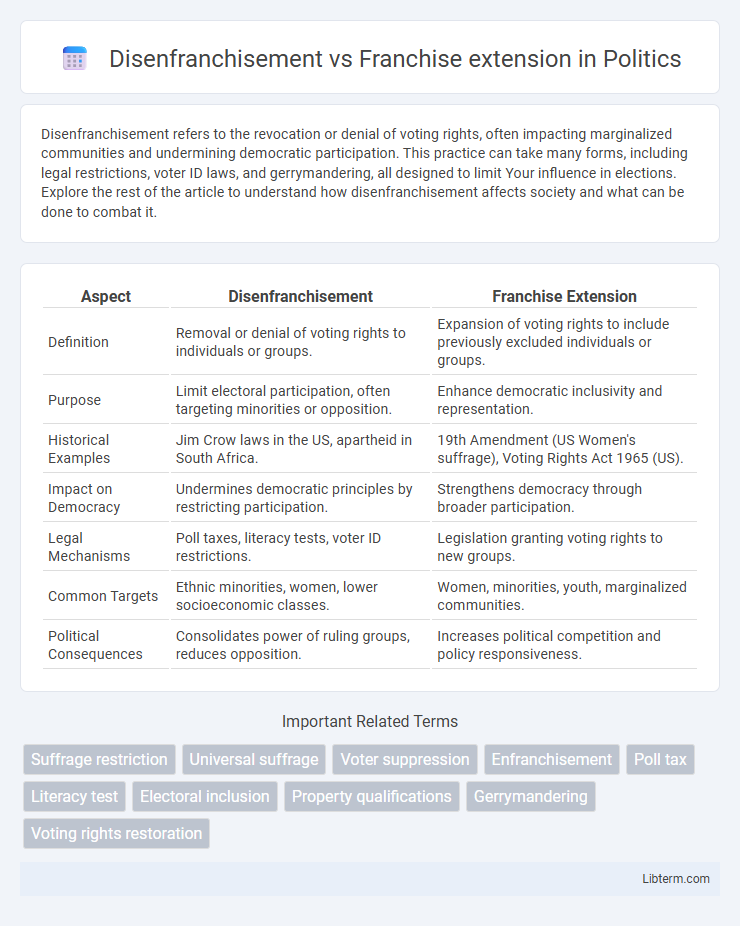Disenfranchisement refers to the revocation or denial of voting rights, often impacting marginalized communities and undermining democratic participation. This practice can take many forms, including legal restrictions, voter ID laws, and gerrymandering, all designed to limit Your influence in elections. Explore the rest of the article to understand how disenfranchisement affects society and what can be done to combat it.
Table of Comparison
| Aspect | Disenfranchisement | Franchise Extension |
|---|---|---|
| Definition | Removal or denial of voting rights to individuals or groups. | Expansion of voting rights to include previously excluded individuals or groups. |
| Purpose | Limit electoral participation, often targeting minorities or opposition. | Enhance democratic inclusivity and representation. |
| Historical Examples | Jim Crow laws in the US, apartheid in South Africa. | 19th Amendment (US Women's suffrage), Voting Rights Act 1965 (US). |
| Impact on Democracy | Undermines democratic principles by restricting participation. | Strengthens democracy through broader participation. |
| Legal Mechanisms | Poll taxes, literacy tests, voter ID restrictions. | Legislation granting voting rights to new groups. |
| Common Targets | Ethnic minorities, women, lower socioeconomic classes. | Women, minorities, youth, marginalized communities. |
| Political Consequences | Consolidates power of ruling groups, reduces opposition. | Increases political competition and policy responsiveness. |
Defining Disenfranchisement and Franchise Extension
Disenfranchisement refers to the systematic removal or denial of voting rights from individuals or groups, often based on factors such as race, gender, or socio-economic status, which restricts their participation in democratic processes. Franchise extension involves the expansion of voting rights to previously excluded populations, aiming to create a more inclusive and representative electoral system by lowering barriers such as age, property ownership, or citizenship requirements. Both concepts are central to discussions on electoral justice, with disenfranchisement limiting political voice and franchise extension promoting equal access to suffrage.
Historical Context of Voting Rights
Disenfranchisement historically targeted African Americans, women, and other marginalized groups through mechanisms like literacy tests, poll taxes, and grandfather clauses that suppressed their voting rights. The franchise extension evolved through landmark legislation such as the 15th Amendment (1870), which prohibited racial discrimination in voting, and the 19th Amendment (1920), granting women suffrage, culminating with the Voting Rights Act of 1965 that outlawed discriminatory practices. These legal advancements significantly reshaped the political landscape by gradually expanding voter inclusion and dismantling systemic barriers to democracy.
Key Mechanisms of Disenfranchisement
Disenfranchisement primarily operates through key mechanisms such as voter ID laws, felony disenfranchisement, and restrictive registration processes that disproportionately impact marginalized communities. These tactics systematically reduce electoral participation by creating legal and procedural barriers that prevent eligible voters from casting ballots. In contrast, franchise extension aims to eliminate these obstacles by expanding access and ensuring inclusive voting rights across diverse populations.
Major Milestones in Franchise Extension
Major milestones in franchise extension include the 15th Amendment (1870), which granted African American men the right to vote, the 19th Amendment (1920) securing women's suffrage, and the Voting Rights Act of 1965 that eliminated discriminatory practices such as literacy tests and poll taxes. The 24th Amendment (1964) abolished poll taxes in federal elections, enhancing voter access, while the 26th Amendment (1971) lowered the voting age from 21 to 18, expanding the electorate significantly. These milestones counteracted widespread disenfranchisement caused by systemic barriers, leading to greater inclusivity in the American democratic process.
Social and Political Impacts of Disenfranchisement
Disenfranchisement restricts certain groups from voting, significantly diminishing their political influence and perpetuating systemic inequality, often targeting minorities, low-income individuals, and marginalized communities. This exclusion fosters social alienation, undermines democratic legitimacy, and contributes to policy decisions that overlook the needs of disenfranchised populations. Contrastingly, franchise extension promotes inclusive representation and social cohesion by expanding voting rights and enhancing political participation among historically marginalized groups.
Benefits and Outcomes of Extending the Franchise
Extending the franchise significantly enhances democratic participation by enfranchising historically marginalized groups, leading to more representative governance and inclusive policy-making. It promotes social equity by providing all citizens the right to vote, which strengthens accountability and responsiveness in political institutions. The expansion of voting rights contributes to greater civic engagement, fostering a more robust and resilient democracy.
Case Studies: Global Perspectives
Disenfranchisement and franchise extension reveal contrasting democratic trends worldwide, exemplified by South Africa's post-apartheid voting rights restoration and the United States' ongoing challenges with felony disenfranchisement impacting millions of voters. In contrast, India's universal adult suffrage exemplifies successful franchise extension overcoming colonial and social barriers to empower diverse populations. These case studies highlight how legal frameworks and social movements shape the expansion or restriction of electoral participation across different political contexts.
Legal Frameworks and Legislative Changes
Disenfranchisement laws historically limited voting rights based on race, gender, or property ownership, with legal frameworks such as Jim Crow laws reinforcing systemic exclusion. Franchise extension emerged through landmark legislation like the 15th, 19th, and 26th Amendments, alongside the Voting Rights Act of 1965, dismantling barriers and codifying universal suffrage. Contemporary legislative changes continue to address voter ID laws and redistricting practices, shaping the dynamic landscape of electoral inclusiveness under constitutional and statutory mandates.
Contemporary Challenges in Voting Rights
Disenfranchisement remains a critical issue in contemporary voting rights, disproportionately affecting minority groups through voter ID laws, registration restrictions, and purging of voter rolls. Franchise extension efforts, such as automatic voter registration and restoration of voting rights for formerly incarcerated individuals, aim to counteract these barriers and promote inclusive electoral participation. Legal battles over gerrymandering and access to polling places further highlight ongoing challenges in securing equitable voting access nationwide.
Future Directions for Electoral Inclusion
Future directions for electoral inclusion emphasize reducing disenfranchisement by implementing policies that expand voting rights and simplify registration processes. Innovations like automatic voter registration, enfranchisement of formerly disenfranchised groups, and the use of secure digital voting platforms aim to enhance accessibility and participation. Data-driven reforms targeting marginalized populations seek to create a more equitable and representative democratic system worldwide.
Disenfranchisement Infographic

 libterm.com
libterm.com